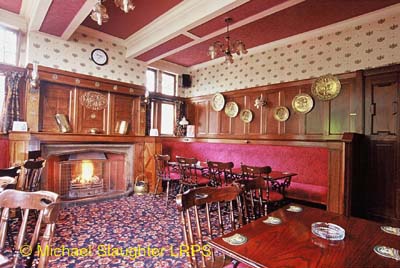|
MANCHESTER, GREATER - Farnworth, Shakespeare National Inventory of Historic Pub Interiors Part One 1 Glynne Street, Farnworth, BL4 7DN Tel: 01204 578282 Web site: www.bravoinns.com/index.asp?cId=61&sId;=27 Opening Hours: 12 to 11 Public Transport: Railway Station: Moses Gate Listed Status: Grade II View this pub on a local map
A fine and unusually intact 1920s pub built for the 'better class' of customer. It was erected in 1926 for Magee Marshall, brewers of Bolton, on a prominent corner site though architecturally it is not particularly distinguished, presenting a rather four-square, Neo-Tudor appearance to the two roads. It is faced with large areas of whitish terracotta interspersed with red brick and, over some of the bays, are gables with touches of half-timbering. It has lost the original etched lower window panels as owners will only replace with plain ones due to the number lost but does have some leaded upper panels with 'MM' in them. But it's the interior that counts.
The layout, amazingly, remains intact and the spaces are fitted out with woodwork of the highest quality making it one of the finest remaining examples of an inter-war suburban pub. The main entrance on Albert Road has solid oak doors and leads into a drinking lobby with a richly carved bar counter topped by a carved wooden shield which almost reaches the ceiling (the same shield appears over the other counters). There is likely to be a parquet floor under the carpet. It is here one finds the one real blemish in the pub - the inter-war tilework of the walls has been papered over - shame!
On the left is the Lounge which has lost its door but it does have a superb Tudor-style wood and stone fireplace with panelled overmantle, original fixed seating and there are two low baffles as you enter the room and another two by the fireplace. The room has good three-quarter height oak panelling all around and unusually detailed bell-pushes for waiter service.
On the front-right there is the News Room (which has in recent years lost its 'News Room' deep etched with gilded lettering and frosted glass panel) which now functions as the Vault. It has a richly carved bar counter topped by a carved wooden shield and a red brick fireplace, which looks like a later addition, but is now blocked up and covered by a radiator. The room has good three-quarter height oak panelling, a tall baffle by the door with frosted glass panels, original fixed seating and until recently it retained the original coat hooks.
The back room (fronting Glynne Street) is described in the glass as the Commercial Room and has another richly carved bar counter topped by a carved wooden shield and a decoratively carved fireplace with panelled overmantle, copper canopy and some tiling. The fixed seating is original with low carved baffles at each end, three-quarter height oak panelling with unusually detailed bell-pushes and, as elsewhere, original elaborate brass door handles. There is a rare wooden internal vestibule from the lobby area with etched and gilded 'Commercial Room' panel (unusual as most vestibule entrances lead from the street).
It is a real pleasure to find the off-sales area untouched (entrance from Glynne Street) - doors lead off it to the Vault (minus its etched and gilded panel) and Commercial Room. It has lower rising sash panels and fixed glazed panels up the ceiling. This screen forms the original bar back fitting which has shelves fixed across it. This tiny room also has richly carved bar counter topped by a carved wooden shield and has a short screen by the external door.
The last public room on the ground floor seems to have been brought into use after serving as part of the former kitchen and has modern dado panelling. Off to the left are new toilets in a flat roof extension as when built the toilets were outside - look for the black and white tiling on the way to the toilets indicating where the original exterior door lobby was situated. An open staircase with leaded window half way up leads upstairs.
The upstairs function room, with a figure '7' on an enamel disc on the door, is at present not accessible to the public. It is an excellent example of inter-war Tudor reinvention; the walls are covered wi
|







